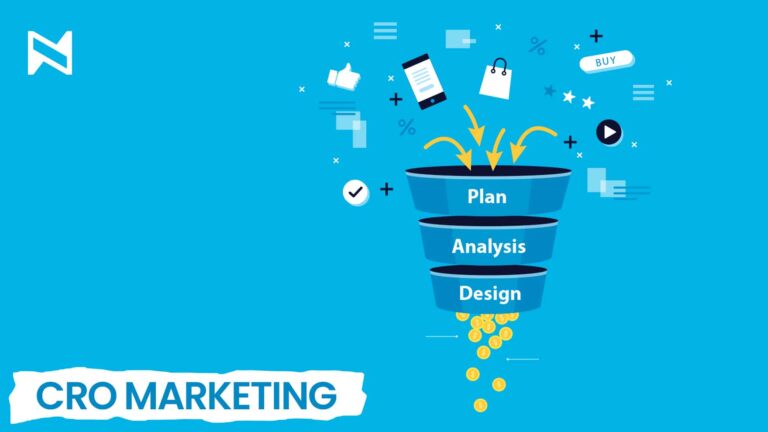A marketing plan that generates internet traffic via social media, SEO, or even sponsored search is a terrific place to start, but it is by no means a guarantee that those visitors will be taking the crucial step of becoming consumers. We shift our attention to CRO marketing for this.
What Is CRO Marketing?
Conversion rate optimization, or CRO, marketing is the methodical process of raising the proportion of site visitors who complete a desired activity, such as joining a mailing list, providing personal information on a form, signing up for a seminar, etc.
With an estimated 223% average ROI from CRO tools and 59% of business, respondents said that CRO is essential to their entire marketing strategy, the subject is unquestionably one that merits investigation.
In other words, optimization is important since it increases the effectiveness of your marketing initiatives. After talking about the theory, let’s now discuss how to put it into practice! While the specific objectives and requirements of your business will determine how CRO is implemented inside a marketing strategy, there is a broad framework for this multi-step procedure.
The CRO Process: What Is It?
In fact, the phases of optimization may be compared to those of the scientific method, which involves making observations and predictions, doing tests, analyzing the findings, and adjusting your strategy as necessary.
Phase 1: Initial Research
The initial step in grasping how to measure conversion rate involves identifying the online behaviors that hold significance for your business. These actions can include various activities such as providing personal information, downloading materials, subscribing for content, spending a specific duration on your website, elevating service levels, or making an online purchase. These activities serve as your key performance indicators (KPIs) and become the metrics against which you measure success.
To establish these KPIs, it’s crucial to have a deep understanding of your consumer personas, your industry, and the specific objectives of your business. Actively seeking input from site users is also essential. Some objectives might be subtle and categorized as “micro-conversions,” like signing up for a newsletter via email. Evaluating your current website and utilizing analytics to identify where and how conversions are occurring most frequently are integral steps in this process.
Hypotheses
You may now start creating testable hypotheses to concentrate prospective CRO strategies on using all the data that has been acquired. These have to be specific about which website sections or pages will be altered and which of your lead demographics are being catered to.
The key term here is “testable”; a hypothesis must be sufficiently explicit and propose a modification that can be realistically executed and its efficacy assessed. Wider Funnel recommends structuring hypotheses as follows:
Because _______, changing ______ into ______ will boost [conversion aim].
For instance, increasing the size of the CTA button by 150% would enhance the click-through rate by 30% since it will catch more users’ attention. Remember that the objective is to observe progress and learn from the findings, not only to prove all of your assumptions correct. The predicted outcome might be a rough estimate.
Put It To The Test
Now it’s time to embark on your experiments! It’s crucial to follow a structured approach similar to the scientific method, where isolating variables is key. In simpler terms, if you modify two elements on a single page and then measure the increase in conversion rate, it becomes challenging to determine which element contributed more significantly or potentially influenced the outcomes of the other element.
In the realm of split or A/B testing, the focus is on one variable at a time, showcasing both versions of the page to two distinct groups of website users. Various types of tests can be conducted, such as evaluating site copy, including site navigation menus, promotions, product descriptions, and page headers. Additionally, factors like social proof, encompassing reviews, testimonials, statistics, and their placement on pages, are important. Calls-to-action, including their size, shape, color, text, font, and location both within your website and on specific pages, are also significant variables to test. Pop-ups, encompassing subscription offers, banner ads, and on-page live chat features, along with visual elements like the distribution of images and videos across the site, warrant attention. Simplified navigation options, such as logging in through social media accounts, streamlined checkout processes (particularly for eCommerce), clearer navigation menus, and easy-access search functionalities, should also be evaluated.
For more intricate evaluations, multivariate testing allows simultaneous testing of multiple changes. However, this method necessitates a larger sample size, meaning you need more visitors to your site to obtain accurate and meaningful results.
Review the Findings
Simply said, the first inquiry is whether any of your hypotheses were found to be true. If so, how thoroughly and conclusively? When drawing these findings, you should keep in mind your initial objectives and KPIs.
More specifically, your findings should have some level of statistical significance, which is based on a variety of variables. Two examples are the overall site traffic and conversion rates between variants. There are many sources that explain why a conversion rate is crucial, but happily, for the majority of businesses, this is a regular built-in function of their analytics software.
Unavoidably, some adjustments won’t have been very helpful or could possibly have hurt conversion. However, failing an exam may be just as beneficial for learning as succeeding. This is why it’s crucial to maintain thorough records of the CRO approach, changes, and prior testing.
Review, Reread, and Rephrase
Step 2 of the CRO process may be skipped during the revision phase in favor of reexamining KPIs, doing more consumer segment research, revising corporate objectives into more achievable (or more ambitious) ones, etc. CRO is an ongoing process, much like science.
What Are The Differences Between CRO And SEO In Digital Marketing?
In the marketing landscape, CRO (Conversion Rate Optimization) and SEO (Search Engine Optimization) are often entangled, leading to confusion and sometimes even perceived as adversaries. However, these elements are distinct yet harmonious components of a comprehensive marketing strategy, capable of collaborating effectively.
SEO primarily focuses on enhancing your business’s visibility in organic search engine rankings through both on-page and off-page tactics. Off-page SEO deals with link development and search engine algorithms, while on-page SEO involves keyword research and incorporation into site content, links, and images.
Certainly, conflicts can arise, especially if changes designed to boost CRO impact the website’s search engine ranking adversely. However, these issues can be resolved through creativity, compromise, and extensive testing.
So, how can SEO and CRO work together? Here are some practices that benefit both areas:
- User-Friendly Pages: Ensure easy navigation with clear and relevant titles.
- Structured Content: Provide well-organized, focused content on specific topics or products.
- Regular Updates: Make frequent modifications to the site’s design and content.
- Content Hierarchy: Implement keywords and header tags for clear content structuring.
- Page Loading Speed: Optimize page loading times, as slow websites can lead to user dissatisfaction and high bounce rates.
In essence, CRO marketing can significantly enhance your campaign’s performance without altering your existing strategy. Begin improving your conversion rates today!
If establishing a conversion rate optimization strategy for your eCommerce business seems challenging, our comprehensive guide can assist you. Discover how to implement a successful eCommerce CRO process in 8 phases by accessing our free guide now. Our methodology has helped an eCommerce business increase conversions by 227% in just 5 months. If they can do it, so can you.
Further Readings:








![Difference between advertising and promotion [Explained]](https://naumandigital.com/wp-content/uploads/2023/02/19-600x400.jpg)
![The Ultimate Guide of telling a Compelling Brand Story [With Examples]](https://naumandigital.com/wp-content/uploads/2023/02/4-600x400.jpg)